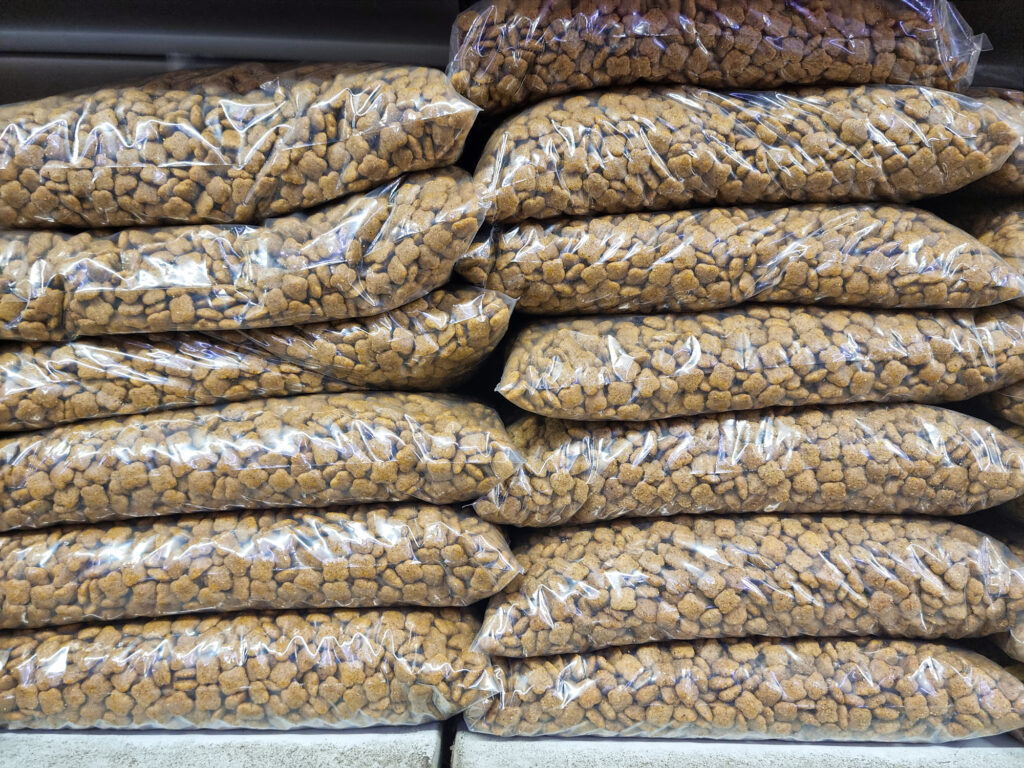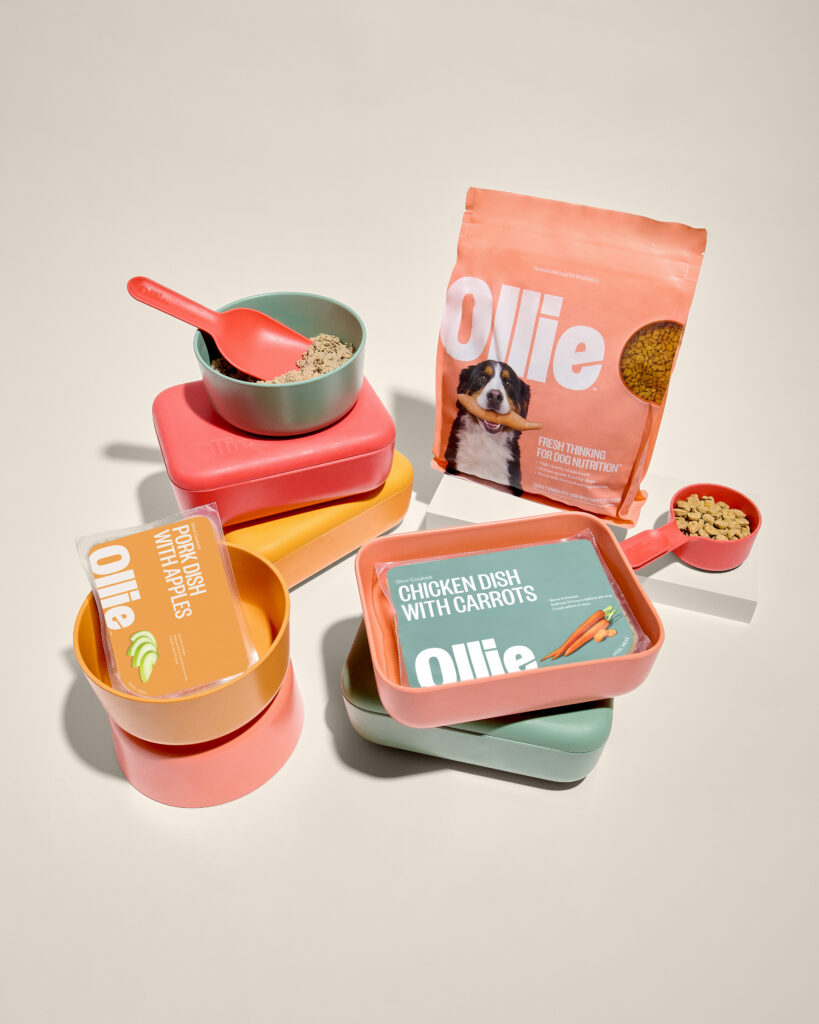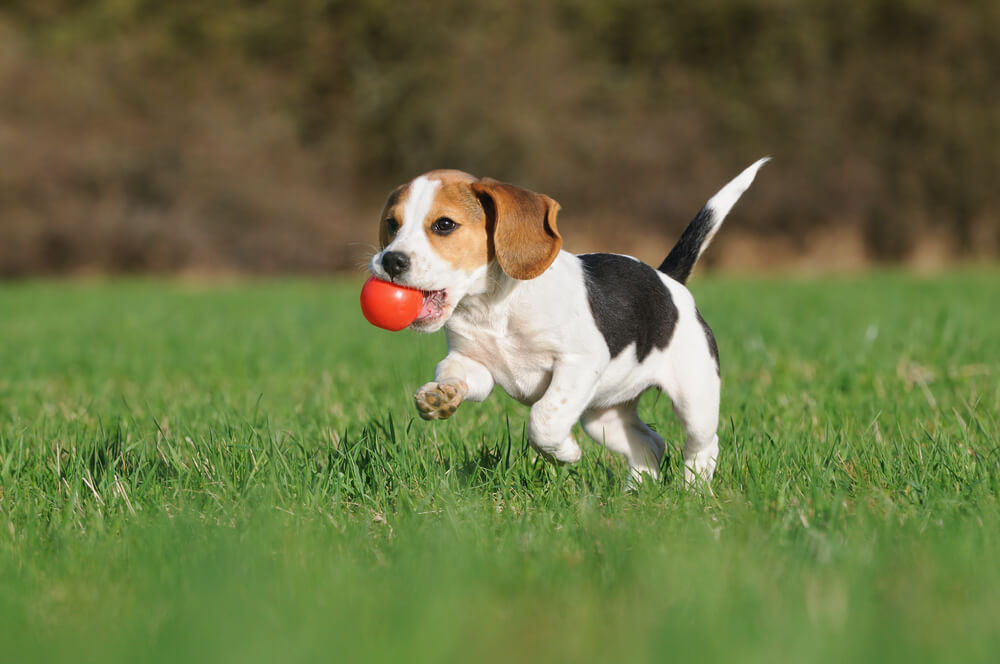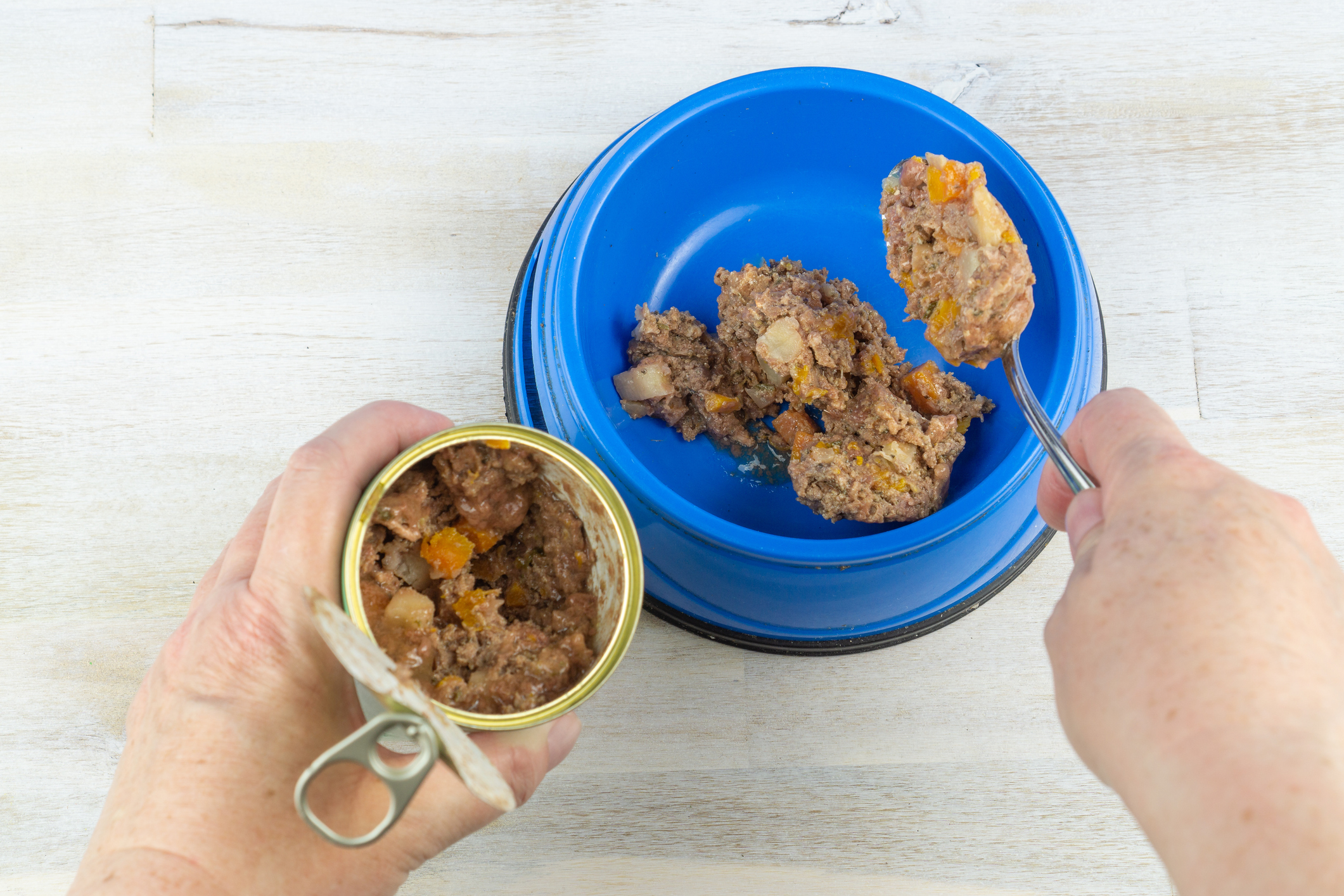Hey Ollie blog readers! We’re offering you an exclusive 60% OFF your starter box! Try now!
Not all dog food is created equal. When choosing a diet, it’s important to consider how the way your dog’s food is made impacts their overall health and nutrition. Understanding the manufacturing process behind different dog food types can help you make more informed decisions when exploring healthy alternatives for your pup.
What Is Extruded Kibble?
Extruded kibble is made when raw ingredients are forced through a die that shapes and cooks the food using hot water or steam to quickly cook the kibble. The process then cuts the food into bite-sized pieces with a blade.
These pieces are puffed with air and sprayed with fats, vitamins, and minerals before being bagged and sealed to prevent the oils from becoming rancid. Some sources report that the extruding process can remove up to 40% of vitamins and minerals from the food [1], but as long as the label indicates the food meets or exceeds AAFCO’s standards for a complete and balanced diet for your dog’s life stage, this shouldn’t be a concern.
How Does Extruded Kibble Compare to Baked Kibble?
While many kibbles use the extrusion process, some brands promote their oven-baked alternatives. This slower cooking method involves cutting kibble into bite-sized pieces and baking them in ovens, similar to how you might bake treats at home.
Key differences you should know:
- Density: Baked kibble doesn’t have air forced into it, making it denser than extruded kibble
- Portion size: Due to higher density, you may need to feed your pup smaller amounts of baked kibble to provide the same nutrition
- Cooking time: Baked kibble requires longer cooking times compared to the quick extrusion process

Is Extruded Kibble Safe for Your Dog?
Generally speaking, extruded kibble is safe for your pup. What matters more than the cooking method are the quality of ingredients used in the food. While some baked food manufacturers claim their products are superior, this isn’t necessarily due to the baking process alone.
You may have heard claims that extruded kibble causes bloat because it expands when mixed with gastric juices in your dog’s stomach. However, there are no scientific studies to support this claim.
If your pup’s diet contains high-quality ingredients and you store it correctly (preventing fats from becoming rancid), you shouldn’t have concerns about the extrusion process compared to other preparation methods.
The Rise of Fresh Dog Food: A Growing Trend
Fresh dog food sales have risen 86.5% since 2021, with experts predicting a 28.12% increase in 2024 [1]. This growing trend reflects your increasing interest in healthier alternatives that prioritize nutrition and quality for your furry family member.
Why Fresh Food Benefits Your Pup’s Health
Studies show that dogs fed fresh diets can live up to 2.5 years longer than those on commercial diets [2], making fresh food one of the most impactful dietary choices you can make for your pup’s longevity.
Key benefits you can expect:
- Superior digestibility: Fresh dog food is 95% digestible, while most kibble ranges from 80-85% digestibility [3]
- Better nutrient retention: Lower cooking temperatures keep natural enzymes and nutrients intact [2]
- Improved health markers: Research shows dogs eating fresh food have lower pro-inflammatory markers [2]
Learn more about the benefits of fresh food and how it can transform your pup’s health.
Understanding Human-Grade Standards
When you’re shopping for premium dog food, you’ll often see “human-grade” on labels. Under AAFCO’s guidelines, manufacturers must document the origins of every ingredient throughout the supply chain to make this claim, which refers to the entire product and every ingredient in it [4].
This means human-grade brands must meet strict manufacturing, packaging, and storage standards equivalent to what’s required for your own food—giving you confidence in what you’re feeding your pup.
Real Health Improvements You Can See
After 14 months on fresh diets, healthy dogs demonstrated improvements in coat condition (70%), bowel frequency (47%), and weight loss targets (67%) [5]. These aren’t just statistics—they represent real improvements you can observe in your own pup.
What Makes Fresh Food Different
Unlike extruded or baked kibble, fresh food maintains a soft texture that’s especially beneficial if your dog:
- Is a senior with dental sensitivities
- Is recovering from surgery or illness
- Has had teeth removed
- Shows decreased appetite (the fresh aroma often encourages better eating)
At Ollie, we work with veterinary nutritionists to develop recipes that capture these benefits through gentle cooking methods that preserve maximum nutrition.

Combining the Best of Both Worlds
You don’t have to choose between convenience and nutrition. Many pet parents successfully combine fresh food with high-quality baked or extruded options to create a balanced approach that fits their lifestyle and budget.
Consider mixing options when:
- You want to introduce fresh food gradually
- You need convenient options for travel
- You’re working within budget constraints
- Your pup enjoys variety in their meals
Explore our mixed meal plans to find the perfect balance for your pup’s needs and your lifestyle.
Making the Right Choice for Your Pup
The cooking method is just one factor when selecting your dog’s food. Our experts recommend focusing on these essential criteria:
What You Should Look For
- Ingredient quality: Choose foods with whole, recognizable ingredients
- Life stage appropriateness: Ensure the food matches your dog’s age and activity level
- AAFCO compliance: Look for nutritional adequacy standards that meet or exceed AAFCO requirements for “complete and balanced” nutrition [6]
- Your dog’s individual needs: Consider any allergies, sensitivities, or health conditions
Whether you choose extruded kibble, baked options, or fresh food, the most important factor is selecting a high-quality diet that meets your pup’s nutritional needs and supports their overall health and wellbeing.
How Ollie’s Fresh Food Approach Works
At Ollie, our approach differs from traditional kibble manufacturing. We work with veterinary nutritionists to create recipes that are gently cooked to preserve maximum nutrition. We then pack these meals into convenient portions and freeze them to maintain freshness until your pup is ready to eat.
This method ensures your dog receives the full nutritional benefits of each ingredient without the nutrient loss associated with high-heat processing.
Frequently Asked Questions
Is fresh food really better than extruded kibble?
Research consistently shows that fresh dog food is superior to kibble [2], offering higher digestibility rates and better nutrient absorption for your pup.
What exactly does “human-grade” mean for dog food?
Human-grade is a regulated term with specific AAFCO guidelines requiring all ingredients meet human food standards [7], giving you the same quality assurance you expect from your own food.
How should I transition my dog to fresh food?
A gradual 5-10 day transition period leads to lasting benefits that make the adjustment worthwhile [2]. Start by mixing small amounts of fresh food with your current food, gradually increasing the ratio.
Are there any dogs that shouldn’t eat fresh food?
Fresh food may not be suitable for dogs with certain medical conditions or decreased immune function, and some brands may lack essential nutrients [8]. Always consult your veterinarian before making significant dietary changes.
How do I know if a fresh food brand is high quality?
The best fresh dog food comes from reputable companies who work with board-certified veterinary nutritionists and adhere to AAFCO nutrition guidelines [8].
Ready to give your pup the nutrition they deserve? Visit MyOllie.com to discover how our recipes can transform your dog’s health and happiness with fresh, human-grade ingredients delivered right to your door.
Citations
[1] https://www.dogster.com/dog-nutrition/dog-food-trends
[2] https://wagtantrum.com/blogs/news/why-fresh-dog-food-could-add-years-to-your-pets-life-2025-guide
[3] https://us-en-olliedogfood.com/
[4] https://fourleafrover.com/blogs/natural-health/aafco-guidelines-for-human-grade-dog-food
[5] https://www.frontiersin.org/journals/animal-science/articles/10.3389/fanim.2025.1506003/full
[6] https://www.petmd.com/dog/nutrition/What-Is-AAFCO-and-What-Does-It-Do
[7] https://www.aafco.org/consumers/understanding-pet-food/frequently-asked-questions
[8] https://www.petmd.com/dog/nutrition/pros-and-cons-fresh-dog-food
Tagged As:

The nutrition your dog needs,
the food they want.

Enjoying our articles? Subscribe our Newsletters and get new articles directly to your inbox
You might also like
18 August 2025
3 MINS READ
5 Risks of Canned Dog Food Pet Parents Miss
While canned dog food might seem like a convenient choice for your pup, it carries several hidden risks that could impact their health. Understanding these concerns will help you make better decis…
by Ollie Pets
18 August 2025
9 MINS READ
Nourish Skin from Within: Fresh Dog Diet Benefits
If your dog is constantly scratching, licking their paws, or has a dull, flaky coat, it’s not just frustrating—it could be a sign that something’s off in their diet. Skin and coat issues are som…
by Ollie Pets
18 August 2025
6 MINS READ
How Much To Feed Your Puppy: Easy Cups-to-Weight Chart
Puppies have rapidly changing nutritional needs as they develop from tiny bundles of energy into healthy, happy adult dogs. Growing puppies need more calories, fat, protein and essential nutrients…
by Ollie Pets







